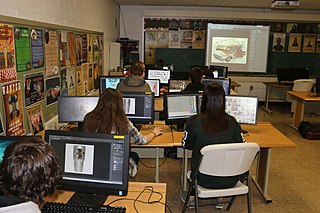
In the United States, education is provided in public and private schools and by individuals through homeschooling. State governments set overall educational standards, often mandate standardized tests for K–12 public school systems and supervise, usually through a board of regents, state colleges, and universities. The bulk of the $1.3 trillion in funding comes from state and local governments, with federal funding accounting for about $260 billion in 2021 compared to around $200 billion in past years.

A standardized test is a test that is administered and scored in a consistent, or "standard", manner. Standardized tests are designed in such a way that the questions and interpretations are consistent and are administered and scored in a predetermined, standard manner.

Education in Canada is for the most part provided publicly, funded and overseen by federal, provincial, and local governments. Education is within provincial jurisdiction and the curriculum is overseen by the province. Education in Canada is generally divided into primary education, followed by secondary education and post-secondary. Education in both English and French is available in most places across Canada. Canada has a large number of universities, almost all of which are publicly funded. Established in 1663, Université Laval is the oldest post-secondary institution in Canada. The largest university is the University of Toronto with over 85,000 students. Four universities are regularly ranked among the top 100 world-wide, namely University of Toronto, University of British Columbia, McGill University, and McMaster University, with a total of 18 universities ranked in the top 500 worldwide.
The Ontario Academic Credit (OAC) (which may also be known as 12b) (French: Cours préuniversitaire de l'Ontario or CPO) was a fifth year of secondary school education that previously existed in the province of Ontario, Canada, designed for students preparing for post-secondary education. The OAC curriculum was codified by the Ontario Ministry of Education in Ontario Schools: Intermediate and Senior (OS:IS) and its revisions. The Ontario education system had a final fifth year of secondary education, known as Grade 13 from 1921 to 1988; grade 13 was replaced by OAC for students starting high school (grade 9) in 1984. OAC continued to act as a fifth year of secondary education until it was phased out in 2003.
Education in China is primarily managed by the state-run public education system, which falls under the Ministry of Education. All citizens must attend school for a minimum of nine years, known as nine-year compulsory education, which is funded by the government.
Gifted education is a sort of education used for children who have been identified as gifted and talented.

Twelfth grade is the twelfth year of formal or compulsory education. It is typically the final year of secondary school and K–12 in most parts of the world. Students in twelfth grade are usually 17–18 years old. Some countries have a thirteenth grade, while other countries do not have a 12th grade/year at all.
University admission or college admission is the process through which students enter tertiary education at universities and colleges. Systems vary widely from country to country, and sometimes from institution to institution.

The Nationwide Unified Examination for Admissions to General Universities and Colleges (普通高等学校招生全国统一考试), commonly abbreviated as Gaokao, is the annual national undergraduate admission exam of China, held in early June. The exam is held by provincial governments under directions from the Ministry of Education and is required for undergraduate admissions to all higher education institutions in the country. The Gaokao is taken by high school seniors at the end of their final year.

College admissions in the United States refers to the process of applying for entrance to institutions of higher education for undergraduate study at one of the nation's colleges or universities. For those who intend to attend college immediately after high school, the college search usually begins in the eleventh grade with most activity taking place during the twelfth grade. Applications to many schools are due in October or November of senior year for Early Decision or Early Action, or in December or January of their senior year for Regular Decision, though the timeline may vary depending on the universities, some having an earlier deadline due to the fact that the admissions process may weigh in more on transcripts. Students at top high schools may often begin the process during their tenth grade or earlier. There are considerable numbers of students who transfer from one college to another, as well as adults older than high school age who apply to college.

Education in Nigeria is overseen by the Federal Ministry of Education. The local authorities take responsibility for implementing state-controlled policy regarding public education and state schools. The education system is divided into Kindergarten, Primary education, Secondary education, and Tertiary education. Nigeria's federal government has been dominated by instability since declaring independence from Britain, and as a result, a unified set of education policies is yet to be successfully implemented. Regional differences in quality, curriculum, and funding characterize the education system in Nigeria. Currently, Nigeria possesses the largest population of out-of-school learning youths in the world. The educational systems in Nigeria are divided into two the public where the student only pays for Parents Teachers Association (PTA) while the private where students pay school fees and some other fees like sports, exam fees, computer fees etc. and they are costly
Education in the Philippines is compulsory at the basic education level, composed of kindergarten, elementary school, junior high school, and senior high school. The educational system is managed by three government agencies by level of education: the Department of Education (DepEd) for basic education; the Commission on Higher Education (CHED) for higher education; and the Technical Education and Skills Development Authority (TESDA) for technical and vocational education. Public education is funded by the national government.
The American Council on Education (ACE) is a nonprofit 501(c)(3) U.S. higher education association established in 1918. ACE's members are the leaders of approximately 1,700 accredited, degree-granting colleges and universities and higher education-related associations, organizations, and corporations. The organization, located in Washington, D.C., conducts public policy advocacy, research, and other initiatives related to key higher education issues and offers leadership development programs to its members and others in the higher education community.
Direct instruction (DI) is the explicit teaching of a skill set using lectures or demonstrations of the material to students. A particular subset, denoted by capitalization as Direct Instruction, refers to the approach developed by Siegfried Engelmann and Wesley C. Becker that was first implemented in the 1960s. DI teaches by explicit instruction, in contrast to exploratory models such as inquiry-based learning. DI includes tutorials, participatory laboratory classes, discussions, recitation, seminars, workshops, observation, active learning, practicum, or internships. Model includes "I do" (instructor), "We do", "You do".
In South Africa, matriculation is the final year of high school and the qualification received on graduating from high school, and the minimum university entrance requirements. The first formal examination was conducted in South Africa under the University of the Cape of Good Hope in 1858. In general usage, the school-leaving exams, which are government-administered, are known as the "matric exams"; by extension, students in the final year of high school are known as "matriculants" or, more commonly, "matrics". Once the Matric year has been passed, students are said to have "matriculated".
Syracuse University Project Advance (SUPA) is an educational program that provides high school students with the opportunity to take Syracuse University courses in their own schools during the regularly scheduled school day. After successful completion of the course(s) they can request to transfer the credits they earn into the colleges/universities they attend after high school. This is an example of a Concurrent Enrollment Program or Partnership (CEP).

The term senior, in regard to education, has different meanings depending on the country.
Academic achievement or academic performance is the extent to which a student, teacher or institution has attained their short or long-term educational goals. Completion of educational benchmarks such as secondary school diplomas and bachelor's degrees represent academic achievement.

In the United States, elementary schools are the main point of delivery of primary education, for children between the ages of 4–11 and coming between pre-kindergarten and secondary education.
Educational interventions for first-generation college students (FGCS) are programs intended to provide resources and make education more attainable and desirable for FGCS and their families. A study by Alex Casillas has identified that "FGCS […] face greater pressure not to go to college, either because of a lack of role models or because of pressure to contribute to their family's financial needs." Many interventions are being explored to lower and/or remove the fears and struggles FGCS face regarding their education. These interventions are intended to bridge the gap between FGCS and their educational experience by providing them with the access to information and resources their non-first-generation peers already have. This article discusses several programs currently being implemented, including AVID, GEAR-UP, and after-school programs, in addition to non-profit college access programs and privately funded organizations that work to address access to higher education for underprivileged and first-generation students. There is also critical discussion regarding the pedagogical role of these educational interventions in building a sense of value and belonging in its students.








